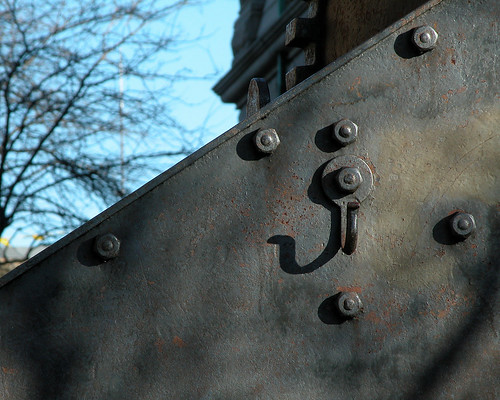Civil War-era Cannon

Tony Sampas takes a close-up look at the Civil War-era cannon that sits between Lowell City Hall and the Pollard Memorial Library


Tony Sampas takes a close-up look at the Civil War-era cannon that sits between Lowell City Hall and the Pollard Memorial Library

Isn’t that a mortar? ;-) Either way, great shots again. Love your eye for light and texture.
I agree, Its a mortar.
Yes, it is a mortar, designed to fire shells in a high arc, over the top of a fortress’s walls during a siege. “Cannon” was used in a more generic sense. I was channeling that famous arms expert Curly Howard who once said, “this is the front end; this is the back end; this is the gimmick you pull.”
According to the Pollard Memorial Library reference desk this is a 13-inch seacoast mortar one of only 26 still believed to still be in existence. It is dated 1862 and was originally located at Fort Pitt, Pennsylvania.
From the Lowell Sun January 17, 1916:
“Big Mortar, Used in the Civil War, Is Now at City Hall on Granite and Cement Base
A relic of the Civil War, a 13 ton mortar, is now located in front of the City Hall on a granite and cement base provided through the generosity of Congressman John Jacob Rogers. The mortar has been in the possession of the city for two years or more, having been obtained from the Portsmouth Navy yard by Congressman Rogers but not until last December was it given a proper location ad foundation. The city neglected to do this, so Congressman Rogers paid the bill and had the work done himself.”
It would be very interesting to have that info on a plaque at the site.
I always assumed it was a WWI cannon.
A plaque would show the public that this is actually a Civil War monument. As they say: “Lest we forget.”
Great shot! The attention to the rivet work really brings the history and raw industry of this “cannon” to the fore. A great hulking bare metal death machine under the shadows of winter barren branches. A stark contrast to how one commonly sees the mortar: under the limbs of playing children.
Susan Fougstedt assistant director and local history librarian at The Pollard Memorial Library lead me to this item which I find interesting as a footnote. The journalism of the day turned the task of moving a big hunk of metal into a charming little story.
The LOWELL SUN 6 O’CLOCK edition, Friday December 24, 1915:
GRANITE BASE FOR MORTAR
The granite base for the mortar presented to the city by Congressman John Jacob Rogers was put in position on the concrete foundation between the Memorial building and city hall this forenoon. Mr. Patrick Cogger had the contract to place the granite base and it required a four-horse hitch to pull it. The monster piece of granite was taken from the Fletcher quarry in Milford, N.H., and was cut at the Fletcher quarry in Westford from which point it was shipped to Lowell. The weight of the granite base is estimated at ten tons and it required the strength, ingenuity and skill of six men well accustomed to the handling of such things to pull the big base in position. It was a slow job, but the men knew their business and handled it without a hitch. The granite base is inscribed as follows: “Dedicated to the city of Lowell by John Jacob Rogers, 1916.” Mr. Rogers volunteered to pay all of the expense connected with the mortar, including the cement base, the granite base and the moving of the mortar from the North Common.”